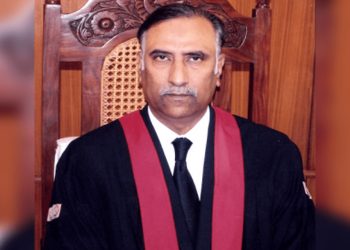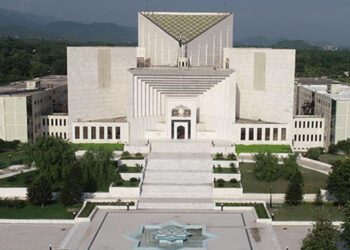A few key points should be understood regarding the Supreme Court’s decision in Punjab, KP elections date.
The Supreme Court had taken suo motu notice of this case fearing that the elections of the two dissolved provincial assemblies would not be held within ninety days, but it was not only suo motu. Two constitutional petitions were also filed in the Supreme Court, one came from the Speakers of the Punjab Assembly and the KP Assembly and it should be remembered that the Speaker is constitutionally considered the custodian of any assembly. The second petition was filed by the then-president of the Islamabad High Court Bar, Shoaib Shaheen.
This decision was taken by a five-member bench of the Supreme Court. The decision was taken by a majority, i.e. by a ratio of three to two. Three judges, Chief Justice Umar Ata Bandial, Justice Muneeb Akhtar and Justice Muhammad Ali Mazhar issued instructions to hold the elections of provincial assemblies within ninety days, while two judges Justice Mansoor Ali Shah and Justice Jamal Mandukhail wrote dissenting notes in the judgment.
Dissenting note on what point?
The two judges who wrote the dissenting judgment, also did not give any opinion regarding holding the election within ninety days or not, in fact, they did not touch this point and only gave an opinion on the point that the Supreme Court should not have taken suo motu notice in this case, also said that since this matter was under hearing in Lahore High Court and Peshawar High Court, therefore Supreme Court should have not taken suo motu notice on it.
Is the decision three-two or 4-3?
According to judicial tradition, the majority decision is considered and accepted. Dissenting judgments are only for record or for the study of law students. They are not even referred to in different cases. Therefore, the majority decision will be important and decisive in this case, which was written by Chief Justice of Pakistan Justice Umar Ata Bandial and Justice Muneeb Akhtar, Justice Muhammad Ali Mazhar has supported it.
Law minister’s strange reasoning
The Attorney General of Pakistan in his personal capacity and the Law Minister Nazir Tarar at the government level have taken the position that they are bound by the decision of the Supreme Court, however, they say that this decision was actually made by four-three. While doing the calculation, they claimed that the two judges who had written dissenting notes while leaving the bench, two judges Mr. Mansoor Ali Shah and Jamal Mandukhail agreed with their opinion, so it became the opinion of four people. The ratio of four became three.
Whose decision is the majority?
The claim of the Attorney General and the Law Minister is wrong and inappropriate in all respects and also very illogical. There are two reasons for this. For one, not two but four judges had separated from the nine-member bench, because two of them were objected by the PDM, so they separated, while the other two judges, Athar Minallah and Justice Yahya Afridi, objected to the Chief Justice’s suo moto. and had separated from the bench showing their disagreement.
Both Judges Athar Manillah and Justice Yahya Afridi did not hear the case completely. After their separation, the five-member bench heard the case for two days, with various parties giving detailed arguments. The lawyer of the Speaker of the Provincial Assemblies gave his position, the lawyer of the President gave his opinion and the bar councils were also heard. In these two days, the case was fully heard, many points were raised, and different lawyers gave their arguments.
All this was heard by the five-member bench, the first two judges had separated from this bench. Therefore, how can the opinion of these two judges be called the judgment of this case? They have not heard the case completely, they have not taken the stand of the lawyers, so how can they pronounce their decision without listening to anyone? Therefore, saying this is completely wrong and inappropriate, rather it is a kind of slander.
Who wrote “Order of the Court”?
The second argument is that the Supreme Court’s “Order of the Court” i.e. the official decision was written by the Chief Justice, if the majority was in favor of Justice Mansoor Ali Shah, he would have written the Order of the Court.
Majority decision
In the first line of the decision is that it is a majority decision in the ratio of three to two. If Justice Mansoor Ali Shah and Justice Mandukhail had disagreed with this, they would have mentioned in their dissenting decision that this decision was not three-two but four-three. He also wrote that the majority decision belongs to these people and not to the Chief Justice. Instead, these two learned judges only gave their dissenting judgment and signed it, accepting the majority judgment.
Thus it became crystal clear that this majority decision is in the ratio of three to two and the claim of the Attorney General and the Law Minister is false and baseless.
Who has the majority? a legal opinion
Those who created confusion on the judgment by saying that the majority is with Justice Mansoor and Justice Mandukhail because they have expressed their consent with Justice Afridi and Justice Athar and thus they have become four. Many things can be said about it, but A few quick points to note:
The honorable judges should have done something else. It is not enough. For example, Justice Yahya Afridi is writing to reject “three applications” in his note dated February 23, but there were two applications, one hundred suo moto proceedings. Let it be considered, then the next question is that in the next para. Why do they leave the matter to the Chief Justice to decide whether to keep them on the bench or not? If they refuse, they’re done.
Ignore that too, then the next question is that when they were discharged on February 23, then on February 27, how they can sit in the 9-member bench and ask the Chief Justice to reconstitute the bench?
Then when the bench was reconstituted, didn’t the previous bench disappear? The question arises whether the new bench should have been 9 members or 5 members, but the question does not arise whether the opinion of the judges of the previous bench should be included with the new bench or not.
(Dr. Muhammad Mushtaq, Legal Expert, Professor of Law)
Key decision points
In its majority decision, the Supreme Court first explained the background and details of two legal points, such as Pakistan’s system is parliamentary and there is no parliament without the National Assembly or the provincial assemblies, and without elections, the parliament cannot be formed, thus the constitutional ban. How important it is to hold elections accordingly, etc.
The Supreme Court has issued an order to conduct the elections of both provincial assemblies within ninety days. The Election Commission has been asked to play an active role.
After detailing the various legal assumptions and situations, the court said that the advice of dissolution of the assembly in Punjab was not signed by the provincial governor, but he could have given the date of the election, if he did not do so, then the election will be held by the honorable president. The date may be given in consultation with the Commission. As far as Punjab is concerned, the Supreme Court declared the process of giving a date by the President as legal and valid.
However, it said that the President can change it slightly in consultation with the Election Commission of Pakistan. The advice of dissolution of KP Assembly was signed by Governor Ghulam Ali, so it was the constitutional responsibility of the Governor to give the date of the election, he did not use his constitutional powers properly by not doing so. The court also made it clear that the election should be held in ninety days, not just announcing the date in ninety days.
According to the Supreme Court, the President has exceeded his authority by giving the date of the election in relation to KP, his order has been terminated. withdrawn.) According to the Supreme Court, the election date in KP will be given by the Governor, in consultation with the Election Commission.
A very important part of this decision, which has not been discussed much, is that the election can go a little further in exceptional circumstances as per the Election Act. That is why the court has instructed the Election Commission that if the number of days required in the election schedule (campaign, submission of documents, etc.) is required, the election date can be extended by a few days in view of the fear of shortage. used the words that this encroachment should be kept to a minimum of days. Some jurists have also criticized this point that in this way the Supreme Court has opened the way to violate the Constitution. However, the court found this method of overcoming a practical difficulty.



































